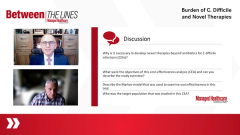
Defining Standard of Care
Overview of Markov model, a tool used for calculating potential clinical outcomes and the associated costs, and its use in the REBYOTA study. The standard of care used in the study is also defined.
Dr. Paul Feuerstadt: What’s important to understand with RBL [live JSLM; Rebyota] and any study that considers a live biotherapeutic product is that it’s an add on therapy. So when we talk about the comparator group, the so-called standard of care, that’s a standard antimicrobial course — what the patient would have received previously without the add on therapy. … [The] control group is the standard of care for the antimicrobial and then the comparator group, the study group, is the group that has that antimicrobial plus a treatment like RBL. Within the pivotal phase 3 trial considering RBL, patients with one or more recurrences of C. diff all receive standard of care, had a washout period and then either received the placebo or RBL. Through a Bayesian analysis, the overall efficacy for RBL at eight weeks was 70.6% versus 57.5% in the placebo arm, achieving a statistically significant difference between the two which is why it was granted FDA approval. So with that foundational knowledge in mind, can you explain to us a little bit about what a Markov model is and how it applies to this study?
Dr. Michael Kobernick: [Yes,] Markov model is … a really complex statistical model that has been developed over the years … to apply statistics to clinical science and clinical evaluation. What it does is it takes potential clinical outcomes and it creates groups of them and then it creates a likelihood that one or the other will occur and the cost associated with that. … [In] C. diff, it really talks about the likelihood in cost of developing complications in groups that have, as you mentioned, the standard-of-care antibiotics in groups that have RBL as the add-on therapy. It generates cost associated with them that can then be interpreted to … [mean] we know this treatment is clinically effective but how much does it cost? Does it cost way too much to get a desired result? … There’s a lot to argue back and forth about the desired result and the cost or does it cost an appropriate amount? I think that’s the essence of the Markov model. It’s statistically valid. It’s an acceptable way, a very acceptable way to compare costs between treatment groups and it’s a very good adjunct, the clinical trial that you mentioned.
Transcript is AI-generated and edited for clarity and readability.
Newsletter
Get the latest industry news, event updates, and more from Managed healthcare Executive.


















































